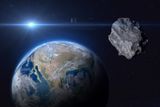Scientists Explore Nuclear Options for Potential Lunar Impact in 2032

Asteroid 2024 YR4, a celestial object previously identified as a potential threat to Earth, may instead collide with the Moon in December 2032. Updated models indicate that the chance of the asteroid impacting the Moon has risen to approximately 4 percent, while the likelihood of it hitting Earth has significantly decreased to about 1 percent. This shift has prompted scientists, including several from NASA, to explore intervention strategies aimed at deflecting or destroying the asteroid before any potential impact.
In a preprint paper published on arXiv in September 2025, researchers discussed various methods for addressing the threat posed by 2024 YR4. One of the more dramatic proposals involves using nuclear devices to either deflect or obliterate the asteroid. The study suggests that if action is taken soon, nuclear options could be feasible.
Nuclear Options Under Consideration
The concept of utilizing nuclear devices to manage the asteroid’s trajectory is still in the theoretical stage. To deflect 2024 YR4, scientists propose detonating a nuclear device near its surface. This explosion would alter the asteroid’s course by creating thrust through the destruction of a portion of its surface. Alternatively, a direct strike aimed at the asteroid’s core could potentially disintegrate it completely.
Despite these possibilities, the study’s authors caution that nuclear deflection is currently impractical due to limited information about the asteroid’s structure. While NASA estimates the asteroid’s diameter to be around 220 feet, critical details about its mass and composition remain unknown. This lack of data complicates any potential nuclear intervention. The authors of the paper emphasized that without a reconnaissance mission to gather more information, developing a nuclear deflection plan in time for the asteroid’s arrival is unlikely.
Exploring Alternatives and Preparing for Impact
The authors suggest that a more effective strategy could be a method termed “nuclear robust disruption,” where two nuclear devices are set to detonate. The first would aim to destroy the asteroid, while the second serves as a backup. Planning for such missions could commence immediately, allowing for a longer timeline for development. Launch windows for nuclear disruption missions are projected to be between late 2029 and late 2031.
In addition to nuclear options, non-nuclear methods, such as kinetic impactors—spacecraft designed to crash into the asteroid—are also under consideration. However, similar to nuclear deflection, the likelihood of successful deflection remains low compared to destruction with robust disruption missions, which could launch as early as April 2030.
Should scientists choose a no-action approach, an impact from 2024 YR4 on the Moon would not change its orbit but would create a new crater on the lunar surface. This impact could send debris towards Earth, with most particles burning up in the atmosphere. Nevertheless, some larger fragments could contribute to increased micrometeoroid impacts, potentially threatening satellites and the International Space Station (ISS).
The authors of the study advocate for proactive planning for asteroid prevention strategies, regardless of future predictions regarding 2024 YR4’s trajectory. An upcoming close approach in 2028 will provide crucial data to determine whether a lunar impact is likely. Even if the risk of collision is eliminated, a reconnaissance mission could yield significant insights into the asteroid’s characteristics and behavior.
As the scientific community continues to monitor Asteroid 2024 YR4, the exploration of nuclear and non-nuclear options highlights the importance of preparedness in the face of potential cosmic threats.






